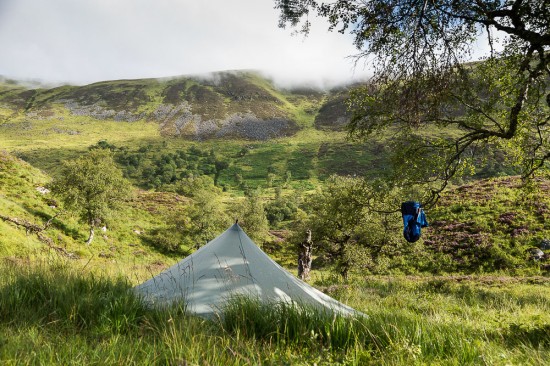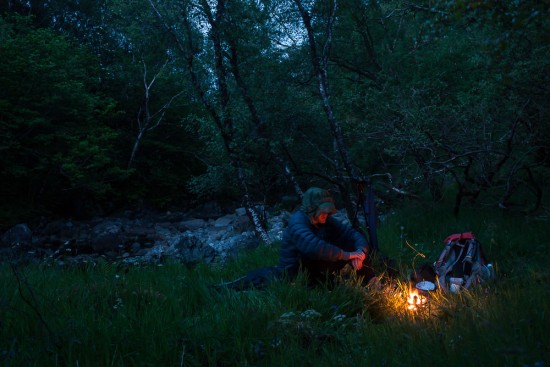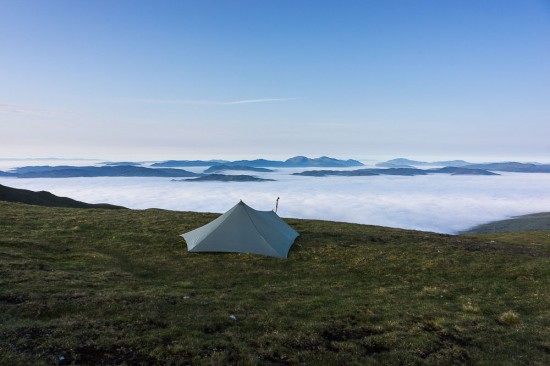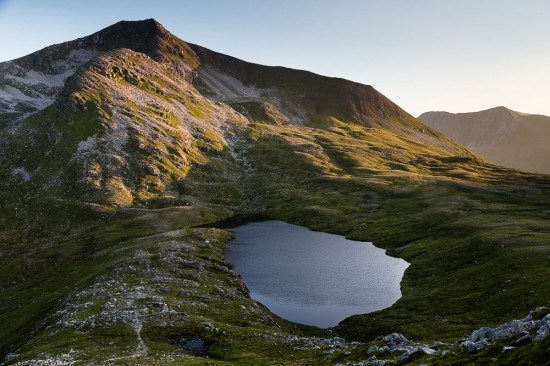
Midges
Easily the most irritating summer highland hazard other than caravans on the A82, midges can and will turn a rose tinted wild camp fantasy into a crawling, biting Cronenberg-esque nightmare. Midge season is early June to early September, with peak season being late July through August – it’s unusual for them to be a serious problem outside of this. What they love is still, damp, warm conditions. There’s an assumption that the west is more afflicted than the east, which is probably down to the ground being slightly wetter, but the Cairngorms midges bite too.

Luscious Creag Meagaidh woodlands after a rainy night – Midge City
There are a few tried and tested solutions, none of which work on their own. Usually I use a single skin tarp all year round, but in the summer I add an inner net. This gives me a little more room to play with than a bivi bag, so I can write, read and get dressed, but it’s not a panacea. As soon as I open the door of the inner to get in or out, I’m doomed. On a still night, an enclosed space with a human expelling carbon dioxide will draw the little blighters for hundreds of metres. They will hover in their thousands outside the net, waiting for my dozy 6am call of nature. My defence therefore needs to be on several fronts.
In addition, then: Midge coils can work well just inside a shelter, especially if you set up multiples. Mine usually get smashed in transit, but I just burn the bits a few at a time dotted around the place. It’s a rare thing to have the ability to make fire in Scotland – usually there’s not enough deadwood, but if you are in a glen with trees, a small, controlled fire will also serve to keep the bugs at a slightly less apocalyptic density. Do be sensible though – don’t use fire on peaty soils, do lay a pit and clear it after, and only burn small dead twigs if there is abundance. And of course, green wood doesn’t burn, so don’t cut anything, ever. Scotland is just beginning to reverse a long trend of deforestation, and needs all the help it can get – deadwood for animal food and cover is an essential part of repairing the ecosystem here.

Midge hill under Bla Bheinn – but a small fire, head net and bivi bag made it work
A decent repellent is also priceless – I completely avoid Permethrin and Deet based products, because they are probable carcinogens for mammals, and known eco-poisons, especially in aquatic environments. As a replacement, the new formula of ‘Smidge’ is great. Slap it on generously; you’re going to need it!
It goes without saying you need to keep your arms and legs covered when you are stationary, doesn’t it? Scottish midge varieties have shallower jaws than larger bugs like mosquitos, so that even thin woven fabrics will act as a barrier. Leggings, Long john’s, Ron Hill’s or your hiking trousers will all keep these pesky critters at bay. Also, bring a baseball cap, or similar brimmed chapeau, to accompany your very first line of defence – a head net. The bill or brim of the hat keeps the sun off your face and the net away from your mouth, which is where they will congregate. A head net is absolutely essential – it’s no joke having scores of tiny bloodsucking insects dive-bomb your face holes.
If you are visiting from the US or Australia, don’t assume bug protection you bring in will work here. Sand fly and black fly are both bigger than the Scottish midge, so the mesh on your shelter and head net needs to be extremely fine to keep them out.

Staying high to avoid the bugs – a 6am summer inversion on the Ben Lawers range
By far the best solution is to choose your campsite well. Midges are so small they can’t withstand much of a breeze, so in the summer, choose an airier campsite than you might in cooler seasons. Try and avoid spongy, mossy ground, also areas near still water if possible – these are all prime breeding grounds. Easier said than done in Scotland, of course.
I used to assume an inner was the only way to go in the summer, but I’ve been experimenting with a simple tarp and bivi setup, and the additional ventilation has worked to my advantage in the right conditions. If there is no breeze at all, though, there is nowhere to hide. Lastly, it can be a good idea to leave your shelter up until you have packed everything else to leave. That way you can always dive in if it gets unbearable.
ClegsAka horse flies, are in a different league. They can eat you alive in the glens especially if there are livestock nearby. Where a midge bite will result in an itchy lump, a cleg can draw blood. They can stay airborne in breezier, sunnier conditions than midges. It’s pretty essential to cover up and keep moving in cleg territory, but they don’t like Smidge much either. I once saw a wasp systematically dismember 10 of these monsters in a single sitting inside a tent, so maybe camp near a wasp’s nest? Maybe not…
Ticks
Saving the best till last, the season for these parasites can start slightly earlier and finish later. They embed themselves in your flesh, hang on until they die, and are abundant in areas with sheep, deer and hares. Ticks can carry Lyme’s disease, which attacks the central nervous system and will definitely spoil your weekend (and possibly the year or two after). Similar to midges, they are attracted to dark colours and bare flesh. In summer I wear lighter coloured trousers and thin trail running style gaiters to keep them at bay. I’m lucky enough to not be too troubled by ticks (blood type?) but I still check myself over at least once a day for anything that shouldn’t be attached, especially in, um, bodily folds and creases.

The Mamores – one of my favourite ever camps – a dry year and a breeze meant a pitch near the lake was possible
Need the loo? Wait, and go where there is a breeze, and low vegetation. Take it from me – midge bites on your soft parts are not pleasant… and let’s not even think about a tick somewhere delicate you can’t reach.
I hope all that doesn’t put you off – it shouldn’t. In high summer, the highlands are gloriously abundant in wildlife and a riot of colour. You might still get the odd bite, but it’ll be worth it.

